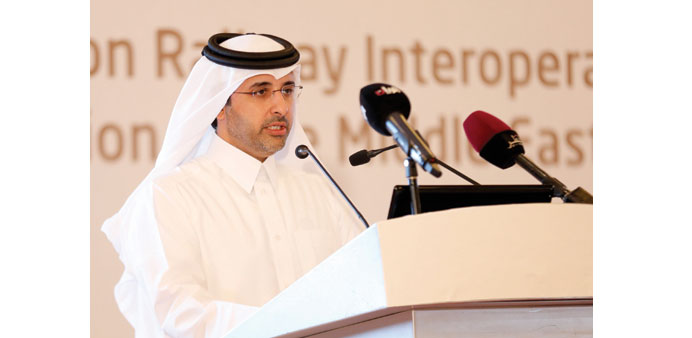By Ramesh Mathew
Staff Reporter
Long-distance passenger trains to be run between Qatar and other GCC countries, after the completion of the fourth phase of the railway construction across the state during the early 2030s, are expected to hit speeds of anywhere between 220 and 350km per hour.
“Qatar will be served by one of the best railway systems to be built ever and it would accelerate GCC’s economic growth,” Qatar Railways Company (Qatar Rail) managing director Abdulla Abdulaziz al-Subaie stated yesterday.
Addressing the opening of the first International Conference on Railway Interoperability, Standardisation, Harmonisation in the Middle East, hosted by Qatar Rail and Paris-headquartered UIC, al-Subaie explained that Qatar would also see the introduction of freight trains of speeds nearing 120km per hour.
Terming the regional railway development as “one with enormous potential to facilitate good growth among the GCC states”, al-Subaie said all efforts were being executed in line with the vision of the whole GCC region.
“Under the Qatar Rail Development Programme, the railway works are going on currently to develop connectivity between not only the major towns of the country but also with some of the large-scale industries as well,” the official stated.
Qatar Rail is adhering to the country’s national transportation objectives and requirements enunciated in the Qatar National Development Strategy and works are carried out in line with the goals and objectives of the Qatar’s National Vision 2030 and its four pillars of economic, social, human and environmental development.
Besides the Doha Metro and the Lusail City Light Rail Transit, which are currently underway, Qatar Rail, he said, was going on in full steam on the development of a long-distance line which would form a vital link to the ambitious GCC cross-border railway network comprising all six states of the region.
“The ongoing phase of the railway programme includes the laying of nearly 143km of operational tracks with 35 turnouts, one station, three freight yards, one inter-modal yard, 26 bridges and 59 culverts. Once the fourth and final phase is completed in 2030, this network will include lines to the GCC countries, the new port, and Hamad International Airport (HIA).”
The Qatar Rail managing director also felt that the long-distance railway network would provide a fast and safe mode of the public transport to the country’s people besides helping to reduce carbon and other greenhouse gas emissions.
A single rail journey, said al-Subaie, would replace hundreds of private car trips, utilising efficient technology and producing less pollution. The arrival of trains, which would be run on electricity, would eventually reduce dependency on fossil fuels, he added.

Abdulaziz al-Subaie speaking at the conference.
